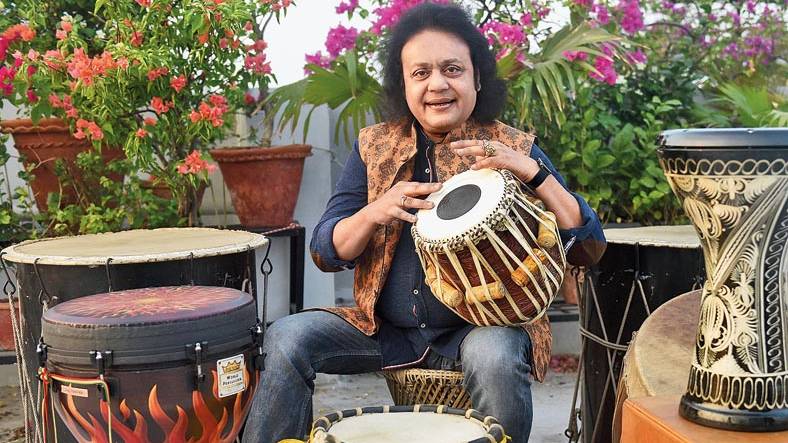Much of the music we hear these days relies on a sound card. “But when you use human pressure... human emotions that you get during a live performance, you will never go through an electronic medium,” says percussionist Tanmoy Bose at his Ballygunge residence. As he sets out on his new ventures — Drum Dreamz: Sound of the Soil, one of his main objectives is to bring back and re-establish the “sound of the soil”. By incorporating new sounds and instruments, he is about to go on a tour in January. He has already made a soft launch to the project in Patna.
He is also aiming to educate listeners about different musical instruments and their importance in history. t2 met him to understand the new project.
The inspiration...
What you hear now is a sound that’s coming from a sound card. But when you use ‘human pressure’, the human emotions that you get during a live performance can never come through an electronic medium. So that is my whole idea, to re-establish the sound of the soil. The concept is to get pure and live musicianship. For which you need immense dedication, practise and learning. I released a CD almost 10 years ago titled Drum Dreamz, which included drums of different countries... which was inspired by an American project called One Giant Leap ... where one person would play one line, then it came to me to contribute a line and so on. Then I thought what if I could go through all the continents using a groove with 20 djembes that I had recorded in Germany! Then we started recording musicians with the djembe groove in sync. Marcos Suzano and I then recorded musicians from Iran and other places. Iranian tabla, chenda, mridangam, tabla, bongo set, cuica, a Brazilian instrument that not too many people know about. It has a tweaking sound and not many people know about it, so I recorded that. It is like a shrill cry. The years passed and now I want to revive it. Drum Dreamz is coming a full circle with a garland of sounds. One groove, different expressions.
The objective...
I have also tried to expand my horizon and got drums from different parts of India. Tabla, pakhawaj, Bangla dhol, dhaak, mridangam, ghatam, khanjira... showcasing the versatility the country has, both classical and folk.
It’s a new concept of live drumming. There is nothing new in this universe that you can contribute to. We can represent. No one has the time to find out what we already have. I want to repack and represent age-old sounds of folk art and classical art of drumming. I did that with worldwide drumming and now I want to do it with folk drums of India... as well as classical ones. There are interesting passages that I want to create, which happens when you play more and more. Say, a question-answer section between a castanet and a mridangam. When you do that it sounds very alien because many people wouldn’t know it exists. So I am repackaging and representing that.
When I was doing this show in Patna, people were expecting a vocalist. I said there will be none and all the kids in the audience had a good time. You need to have the right percussion. If you’re a musician and you listen to something with no beats, will you enjoy it? That is what I want to revive.

Education...
I stayed in Los Angeles once with Raviji (Pandit Ravi Shankar) and I met John Fitzgerald (former head of Remo Drum Company). He told me: “Why don’t you do community drumming?”. A drum circle, which is again an African concept. If kids are made aware of community drumming... where people give adda and I get 10 drums and 10 musicians. They don’t have to be musicians; they can just get drums and play them. Drumming can contribute to such things in life.When you are frustrated you play on the table, which generates a sound. And if you vent out that frustration on a drum you are making music. So that is the concept of drum circle and Drum Dreamz... the awareness around drums.
You see Reels on Instagram for 30 seconds. Once you start playing, those 30 seconds are gone. But if you can engage yourself in a situation where you can consciously make an effort to be a part of something, then you are producing positive energy. There is no language barrier. And there is an age-old tradition in India called Taal Vadya Kacheri, which exists in Carnatic music. The drums play in unison, take rounds and then comes the question-and-answer part.
I also talk about different drums and their history, where they come from. With this venture I am doing it with drums of India, which is already a long list. This will create a situation for the audience where they don’t have to have a lot of knowledge about the subject; they need to enjoy it! All they care about is the groove. So I wanted this venture to have a classical connection, along the lines of Taal Vadya Kacheri, it will involve folk and other drums from popular music.
I was talking about the history of castanets and khartal, and I had said: “Who knew that gypsies carried castanets through central Asia and settled down in Spain? The khartal travelled through the deserts of Rajasthan and became castanets and a part of the flamenco dance. This is why it has 12 counts and has elements of kathak.
Pictures: Pabitra Das
